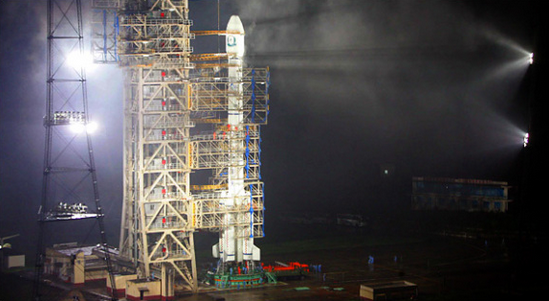Chinese-made Satellite For Bolivia Generates $16 Million In Revenue
| Adrian Darylle Torralba | | Jun 29, 2015 09:27 AM EDT |
(Photo : Reuters) Tupac Katari, Bolivia's Chinese-made satellite, is said to have generated at least $16 million since it was launched in 2013.
Tupac Katari, Bolivia's Chinese-made satellite, is said to have generated at least $16 million since it was launched in 2013.
According to SpaceDaily, in its first year in orbit, the satellite's revenue reached 10 million dollars, and this year, it is nearing 6 million dollars. Ivan Zembrana, director of the Bolivian State Agency said, "It's an approximate figure, last year were close to 10 million and the current we have so far is nearing 6 million dollars." In Dec. 20, 2013, Bolivia's first satellite was launched but did not officially start its commercial operation until April of 2014.
Like Us on Facebook
Zembrana said that the satellite makes a monthly revenue of 1.5 million dollars, but they expect it to rise to 2 million dollars in the coming years. With a yearly revenue of 20 million dollars, the Bolivian government can eventually make use of the profit to repay debts from China.
The minimal part of Bolivia in the expenses used on the satellite was supported by the China Great Wall Industry Corporation who built the satellite and the financial aid amounting to 300 million dollars or 85 percent of the project from the Development Bank of China.
Agencies that have received financial aid from the satellite's revenue include Bolivia's Telesalud or Telehealth program, a medical mission conducted by the Bolivian government that aims to help those in rural areas. Tupac Katari's role in the health program of Bolivia includes treatment in real time through a video conference.
According to the ehealthreporter, Martin Maturano, vice minister for health and promotion, said "this will undoubtly be a defining moment in the history of public health in the country." He also stated that the satellite's contribution is indeed one of the most noble contribution of Information Technology in the country because of its ability to reach areas that are impossible to visit physically by doctor.
Telehealth's 4 stages will be distributed into categories wherein 269 municipalities will enjoy the services of Tele 1. The Tele 2 stage will be used by 61 municipalities, Tele 3 by 9 and the last will be the main platform of the service.
TagsSatellite, china satellite, Tupac Katari, bolivia, Tech News
©2015 Chinatopix All rights reserved. Do not reproduce without permission
EDITOR'S PICKS
-

Did the Trump administration just announce plans for a trade war with ‘hostile’ China and Russia?
-

US Senate passes Taiwan travel bill slammed by China
-

As Yan Sihong’s family grieves, here are other Chinese students who went missing abroad. Some have never been found
-

Beijing blasts Western critics who ‘smear China’ with the term sharp power
-

China Envoy Seeks to Defuse Tensions With U.S. as a Trade War Brews
-

Singapore's Deputy PM Provides Bitcoin Vote of Confidence Amid China's Blanket Bans
-

China warns investors over risks in overseas virtual currency trading
-

Chinese government most trustworthy: survey
-

Kashima Antlers On Course For Back-To-Back Titles
MOST POPULAR
LATEST NEWS
Zhou Yongkang: China's Former Security Chief Sentenced to Life in Prison

China's former Chief of the Ministry of Public Security, Zhou Yongkang, has been given a life sentence after he was found guilty of abusing his office, bribery and deliberately ... Full Article
TRENDING STORY

China Pork Prices Expected to Stabilize As The Supplies Recover

Elephone P9000 Smartphone is now on Sale on Amazon India

There's a Big Chance Cliffhangers Won't Still Be Resolved When Grey's Anatomy Season 13 Returns

Supreme Court Ruled on Samsung vs Apple Dispute for Patent Infringement

Microsoft Surface Pro 5 Rumors and Release Date: What is the Latest?













